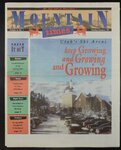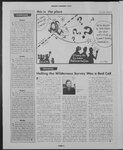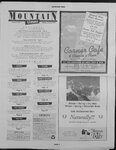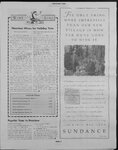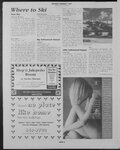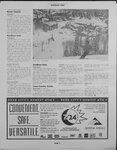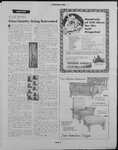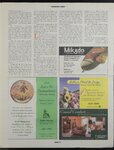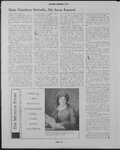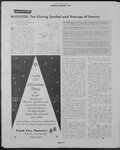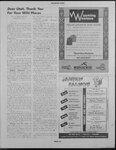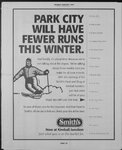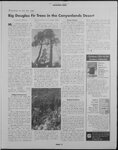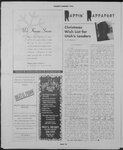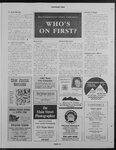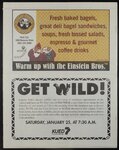| OCR Text |
Show SALE the stripped slopes, metal towers, and native plants. Cutting up the mountains with runs and roads can cause local extinctions. An alpine biological community needs to be contiguous to function over time. For example, some native multistory lodges that give the mountains a tame, industrial look. He believes we must face the cumulative effects of ski resort expansion today. Otherwise, “Ten years from now residents will look around and say, ‘By golly, what happened to our mountains?” @ Construction that churns up alpine such as slope-grading or road building, creates a path along which nonnative weeds invade the mountain- sides. Native vegetation crowded out by these broadly-adapted Benjamin Franklin, Division of Wildlife that books Utah for has is eventually aggressive human no and followers. a botanist for Utah Resources regulations protecting or noted on rodents won't cross a road. If a small population is trapped on one side of a PAGE O * MSR * Permagrin * Sherpa & “ * Northern a) be Lights Tn Denali Oo = a} mi Ar y East 3200 South « Brickyard a1vs Winter adventure at its PEAK! 1140 Plaza 801.484.5044 / 888.4.DENALI PARK CITY'S ONLY ORGANIC GROCERY S Ny THE SEASON GIVING VY) Z YY «> TAKE CARE OF THE PEOPLE YOU LOVE WITH HEALTHY PRODUCTS 649-4561 NATURAL BODY CARE PRODUCTS BULK DRIED FRUITS, NUTS AND SEEDS CHILDRENS TREATS 9-7 MONDAY - FRIDAY 10 - 7 SATURDAY, 12 - 6 SUNDAY GROCERY STORE 1270 IRONHORSE DRIVE ae Shs Nr bl p) Ten) Basketball OF RONG T DDD TE aT en Volleyball Racquetball Oe SHULD] the managing turf, a Smashes. Splashes. Dunks. Dives. Jumps. Volleys. SIIQOINY of the drinking * Powder Wings Kicks. Follies. = ULL 60% water for Salt Lake City and County. In an effective watershed, rain and snow are slowed up and filtered through the natural community of scrub, trees, tundra, and soil. Each new construction project or ski run _ incrementally reduces the ability of the mountainside to filter drinking water. Lewis argues that the growing ski resorts also detract from the Wasatch’s viewshed. Hikers and picnickers—the second and third largest groups of visitors after alpine skiers—must live with r 0 > = 7) F ate HOLIDAY lives at high elevations and nests in crevices on talus slopes. The finch is not a wide-ranging bird, so it is especially vulnerable to habitat loss as well. Park City, Solitude, and Snowbird are building extensive artificial snowmaking facilities, though nature’s own snowmaking system dumps hundreds of inches on them most years. “Utah resorts are investing heavily in artificial snowmaking equipment as much for marketing [to out-of-stateskiers] as for operational reasons,” said Mark Menlove, president of the Utah Ski Association. Advertising artificial snowmaking capability assures out-ofstaters—who must make their ski vacation reservations months in advance— of skiable snow when they arrive. Installing snowmaking equipment requires digging trenches up mountainsides and burying pipes. Charlie Lansche, spokesperson for Park City ski resort, said they try to run the pipes along existing ski runs to avoid cutting down more trees. But Steve Lewis, of Committee to Save Our Canyons, questions the sensibility of Wasatch resorts putting snowmaking equipment “everywhere—even on _ northfacing slopes.” The Wasatch mountains are water- providing Redfeather i] 7) road, it can easily die out. If the rodents in an area die out, the owls, hawks, and coyotes that feed on them disappear as well. Oliver pointed out that the pica, a native Wasatch rodent, inhabits boulder slopes on mountainsides. Pica populations are widely separated and isolated. Further isolation through habitat destruction makes the many pica subspecies vulnerable to extinction during naturally harsh environmental cycles Rosy-finch The Wasatch’s Black shed, * Ty ReeC ean By Mark Gerard “There are a lot of trees going down,” Mike Sieg, U.S. Forest Service’s Salt Lake District Ranger, said about local ski area enlargement. “As_ ski resorts put in quad chairs, they have to widen runs.” How can it hurt the alpine landscape to widen a ski run? “When you cut a ski run into a stand of conifers, you lose bird nesting habitat,” said Larry Dalton of Utah Division of Wildlife Resources. “People think that the displaced bird can just move next door. That’s not true. “The nesting area next door is already taken by a bird that’s defending its territory. The displaced bird must move to a less secure nesting site that’s more apt to be exposed to weather or predators. And it’s unlikely that the bird wil! successfully reproduce.” As humans reduce wildlife habitat, animals are squeezed into smaller areas only for a short period, say wildlife experts. Then they die without breeding and rearing young. Dalton noted that the Wasatch’s elk were eliminated by habitat destruction. Elk winter range in the foothills was invaded by the steady creep of new subdivisions built up the hillsides. The presence of human houses and lawns on elks’ former winter range didn't necessarily kill individual animals, but it did keep them from successfully reproducing. Another problem with ski runs is that “the grassy opening changes the mosaic of the natural alpine community by favoring different small animals— with unpredictable consequences,” said Dalton. A ski run can create habitat inviting to non-native animals like house mice or roof rats that don’t belong there, said zoologist George Oliver. Weeds Atlas Binary More F Avrobics Fewer Animals, * Bring this ad in and receive $1.00 off on Aerobics, Pool, Jacuzzi, or Gym play Good thru February 1997 Racquetball 13 Nenu LENG SSOUIL] Expanding Ski Resorts: x ° Call 645-5100 TURTLE | One Ski Run at a Time VO Taming the Wasatch, ISALEMSALEMS ALE SNOWSHOEING to play! 1200 Little Kate Road Acrobies bSS DED OTSTT 2a |

